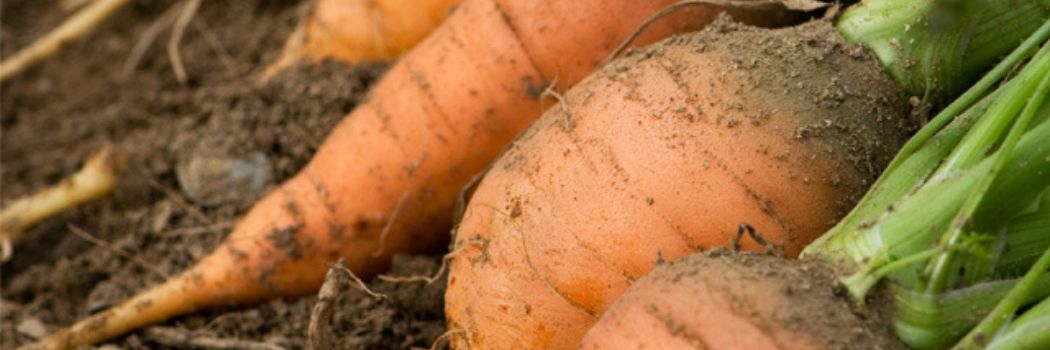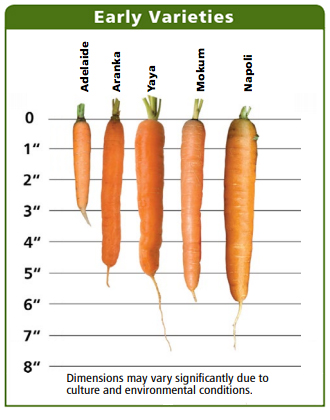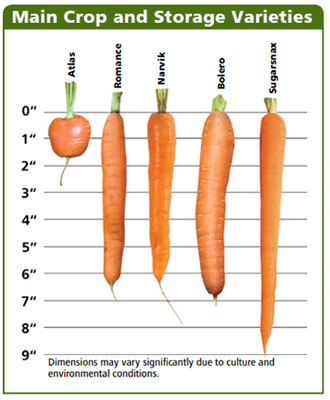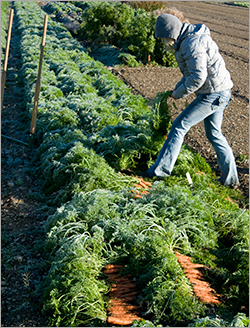- Carrot Growing Guide | Fundamentals of Bed Preparation, Spacing, Weeding & Watering - Part 1
- Carrot Growing Guide | Season Extension to Lengthen Your Carrot Harvest - Part 2
- Carrot Growing Guide | Carrot Harvesting, Handling & Storage - Part 3
- Carrot Growing Guide | Common Carrot Pests & Diseases - Part 4
- Colored Carrot Varieties | Visual Comparison Chart (PDF)
- Carrots | Key Growing Information
- Early, Main Crop & Storage Carrot Varieties | Photo Comparison Chart (PDF)
- Pelleted Carrots | Key Growing Information
- Video: How to Grow Carrots • From Seed to Harvest
- Video: 'Glow Stix Sunrise Mix' Carrots | Exclusively from Johnny's Selected Seeds
- Classic Storage Crops | Post-Harvest Handling & Storage Guidelines
- Winter Growing Guide | Part 6: Recommended Crops & Varieties
- Choosing Carrots: A Guide to Varieties You Will Dig
- Webinar Slide Deck | Choosing Carrots: A Guide to Varieties You Will Dig | PDF
- Choosing Carrots: A Guide to Varieties You Will Dig
- Webinar Slide Deck | Flower Seed Starting Fundamentals | PDF
Carrot Season Extension
Types & Varieties to Expand Your Carrot-Harvest Window
Carrots are a crop which has a conveniently paired set of characteristics: there is a steady, year-round demand for them and they lend themselves nicely to season extension. By making multiple succession plantings of early, main crop, and storage varieties, you can expand your carrot-harvest window, meet the demand, and provide yourself a reliable source of income.
To best achieve this, you will need to sow at 3-week intervals, and know a little about which types to plant, in which sequence, and which ones work best for overwintering and winter harvest. Johnny's line of carrots has been selected to provide for the broadest range of growing conditions and the widest possible harvest window, so you can get the most from your carrot succession planting program. Here is a summary of types, seasonal slots, and what to look for as you plan. Please note, that the following planting recommendations are targeted to the northern tier (Northeast and Midwest U.S.) grower.
#1 • Summer Carrots: Spring Sowing for Summer Harvest
Most types of carrots can be planted in the spring for summer harvests. There are a few exceptions to this, involving variations between different varieties' reproductive triggers and flavors, corresponding to changes in temperature.
- Bolting. Carrots are biennial, taking two years to complete their lifecycle, so they require a "cool" season in order to produce seed. By virtue of this requirement, some types, when exposed to cool spring weather as juveniles, have a tendency to bolt — produce flowers and go to seed. Purple varieties, in particular, will typically bolt prematurely when sown in cool spring conditions.
The types that more readily bolt have a higher cold-dormancy threshold temperature than those that do not bolt as readily. When this threshold is met, they are directed away from the energy-gathering/storing, root-development phase of their life cycle toward the reproductive, flowering/seed-production phase.
When carrots send up flower stalks, the storage portion of the plant becomes woody and fibrous, rendering the crop unpalatable/unmarketable. - Flavor. Although most types can be planted in the spring for summer harvest, in some varieties, maturation during the warmer weather of summer can result in off-flavors that are unpleasant.
These variations are why it is important to choose the right varieties for your spring sowings. Look for these 3 criteria when choosing varieties to plant in spring:
- Varieties described as having good flavor even in warm conditions.
- Earlier-maturing varieties, so they will be ready to harvest before temperatures become too warm.
- Types/varieties that are not characteristically prone to bolting.
#2 • Fall-Harvest Carrots
Just as the flavor of some carrots can be ruined by warmer temperatures, fall-harvested carrot flavor tends to be better because the roots mature under cooler conditions. After a few light frosts, carrot roots often become even sweeter, which explains why fall-harvested carrots are so popular.
Once heavy frost threatens, however, your best bet is to either:
- Mulch beds with thick layers of straw (or whatever is on hand), if feasible; OR
- Cover beds with some thick row cover; OR
- Harvest the roots before heavy frost and prep for storage. To learn more about this process, read our recommendations on Carrot Harvesting, Post-Harvest Handling & Storage.
#3 • Winter-Harvest & Overwintering Carrots
Depending on your location, you may be able to leave carrots in the ground for harvesting through the winter into early spring. This can be facilitated by either mulching heavily or by planting your carrots in tunnels — options for which are also contingent upon climate and weather, as follows:
- Low Tunnels are ideal in locations where there is little to no snowfall, allowing the plastic to be easily lifted or removed to harvest roots when needed.
- High Tunnels or caterpillar tunnels are ideal for higher latitudes, as doors can be affixed to their endwalls, providing readier access to the roots once the winter snows set in.
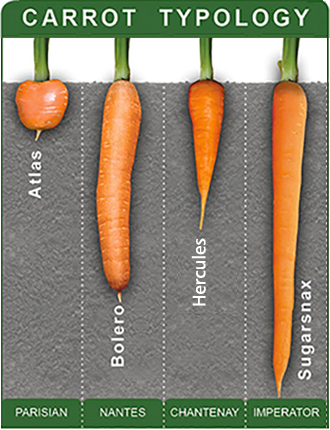
Parisian. Small, round roots. Example: 'Atlas' is an improvement upon the French heirloom with sweet flavor.
Nantes. Cigar-shaped roots with blunt tips, some more pointed and not as blunt-tipped as others. Comprising myriad varieties, this type ranges in length and width from slender, pencil-thin roots to mini (3–4" long) to large (7–8" long). Nantes are popular around the world, particularly in Europe. Example: 'Bolero'
Chantenay. Broad-shouldered, tapered roots, with pointed to slightly rounded tips. As a result of their wedgelike form, Chantenay types typically have strong tops and perform well in heavy soils. Popular in Europe, Asia, and South America. Example: 'Hercules'
Imperator. Long, slender roots often reaching 10" or more in length. Imperator types perform best in deep, light soils that allow their roots to grow straight down, without small obstructions distorting shape. Very popular in the US industrial segment. This is also the type of carrot commonly processed as a "baby" carrot by slicing the long root, then shaving the pieces down to snack size. Example: 'Sugarsnax 54'
Even in areas where low tunnels are appropriate, heavy row covers and mulching may need to be applied to prevent freezing. The trick is to keep the soil insulated just enough to allow for easy digging of the roots throughout winter.
If you can justify using tunnel space for overwintering your carrots (rather than for spinach production, for instance), there are a few advantages to this approach that digging and storing your carrots cannot provide:
- Overwintered carrots still have green tops. While the tops may appear a bit tattered and torn by mid to late winter, they can be snipped at 1–2" above the root shoulder, giving your overwintered carrots a fresher look that distinguishes them from stored carrots.
- You can dig carrots from tunnels whenever needed.
- "Storing" your carrots in the ground means additional free space for other purposes in your storage area.
Making a Year-Round Go of Carrots
Once you know which types to plant and when, extending the carrot harvest window is a matter of following through on each step and keeping track of timing, conditions, and results. Johnny's line of carrots is selected expressly to accommodate a range of conditions and help you provide a year-round supply of this versatile, popular vegetable. We encourage you to explore planting sequences, intervals, types, varieties, and methods to determine the practices that work best for you.
Further Reading
- Next up in our carrot-growing series:
- Carrot Harvesting, Post-Harvest Handling & Storage Tips • Article
- Common Carrot Pests & Diseases • Article
- Fundamentals of Carrot Culture: Bed Prep, Spacing, Weeding & Watering • Article
- More resources:


